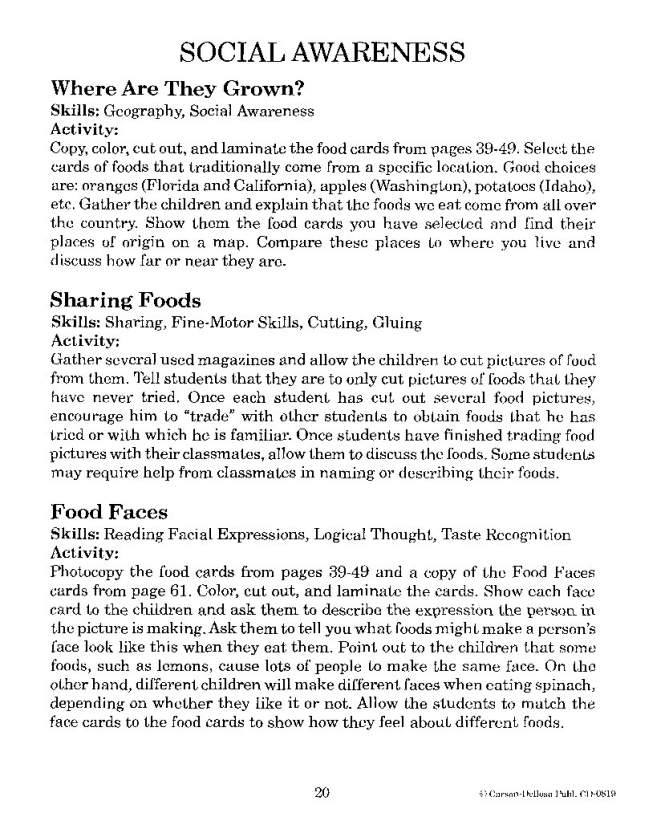20 social awareness1

SOCIAL AWARENESS
Where Are They Grown?
Skills: Gcography, Social Awareness Activity:
Copy, color, cut out, and laminatu the food cards from pa ges 39-49. Select the cards of foods that traditionally come from a spccific localion. Good choices are: oranges (Florida and Califomia), apples (Washington), potatoes (Idaho), eto. Gather the children and explain that Ihc foods wc eat comc from all over tho country. Show thom the food cards you have selectcd and find their places of origin on a map. Compare thesc places to whero you live and discuss how far or near they arc.
Sha ring Foods
Skills: Sharing, Fine-Motor Skills, Cutting, Gluing Activity;
Gather sevcral used magazines and allow the children to cut piclures of food from thcm. Tell students that they are to only cut pietures of foods that they havc never tried. Once each student has cut out sevoral food pietures, encourage him to “trade" with olhcr students to obtain foods that ho has triod or with which ho is familiar. Once students have finished trading food pictures with their classmales, allow them to discuss the foods. Some students may require help from classmatcs in naming or describing their foods.
Food Faces
Skills: Reading Facial Expressions, Logical Thought, Taste Rccognition Activity:
Photocopy the food cards from pages 39-49 and a copy of the Food Faces cards from page 61. Color, cut out, and laminatc the cards. Show each face card to the children and ask them to describo the eicpression the person in the picture is making. Ask them to tell you what foods mightmake a person’s face look like this when they cat them. Point out to the children that some foods, such as Icmons, cause lots of people to make the same face. On tho other hand, dilferent children will make differenl faces when cating spinach, depending on whelher they like it or not. Allow the students to match the face cards to the food cards to show how they feel about differenl foods.
20 »:■ Oan*<W» -l KlkiMO IhJtl. Cl»0S10
Wyszukiwarka
Podobne podstrony:
21 social awareness1 .Social Awareness<rPeople Who Work With Foods Skills: Social Awareness, Care
Gordo Remora Next up on Gordo: Pecple who believe in conspiracy thecries. Are they nuts or just
Supervision for social work in European Union- Gurrent trends and the educational process Jose Reisj
SAVE0229 2What are they doing?People watching Less
skanuj0035 2 1 What s the matter with them? Co im dolega? ....... Molly % >2 Why are they sick to
image011 ■ Are they making love or fighting? Both? ■ Nothing tas
»Video Camera of the 1990s? As soPHisriCArri) as todays Home vkleo cam-eras are, they represent only
16801 SAVE0161 LESSON 1 How much are they? Ile to kosztuje? LESSON 2 Weights and measures Miary i w
SAVE0229 2What are they doing?People watching Less
Lesson p044 44 CONYERSATIONAL PORTUGUESE 44 CONYERSATIONAL PORTUGUESE he, she, is, you are we are
What are they saying?1 What ar* Becky, Lukę and their father saying or thinking? Match tfce sentence
design. K U14 Social P KOI is operatiyc in the indiyidual and team work. K KO 3 competences P K02
więcej podobnych podstron